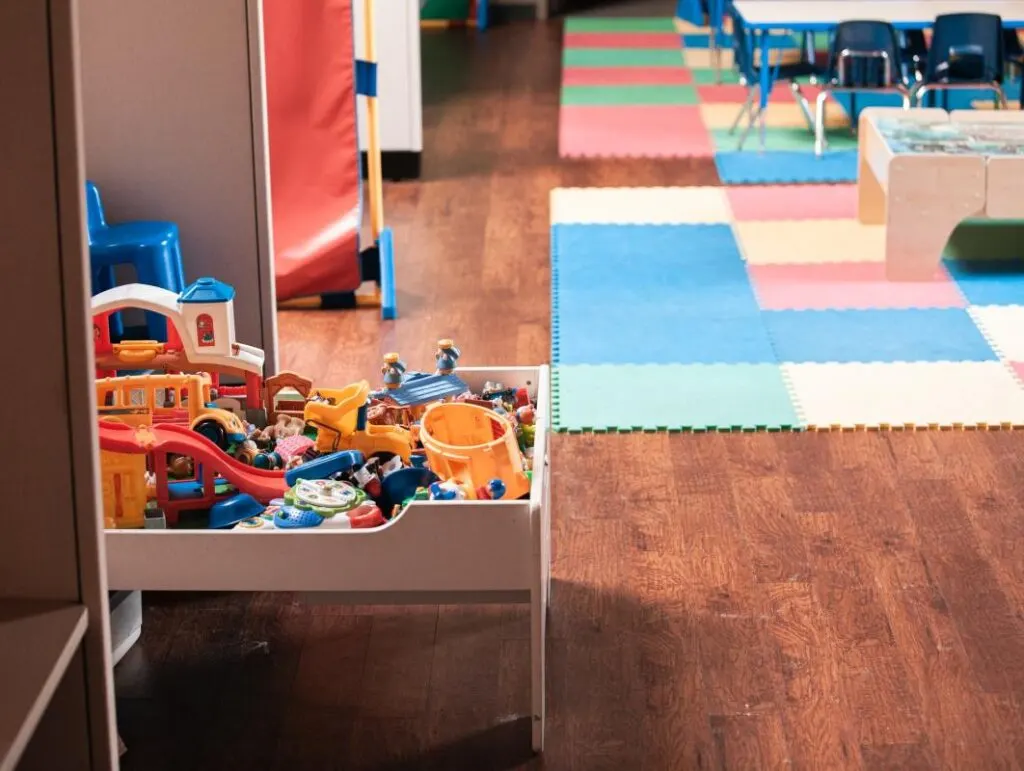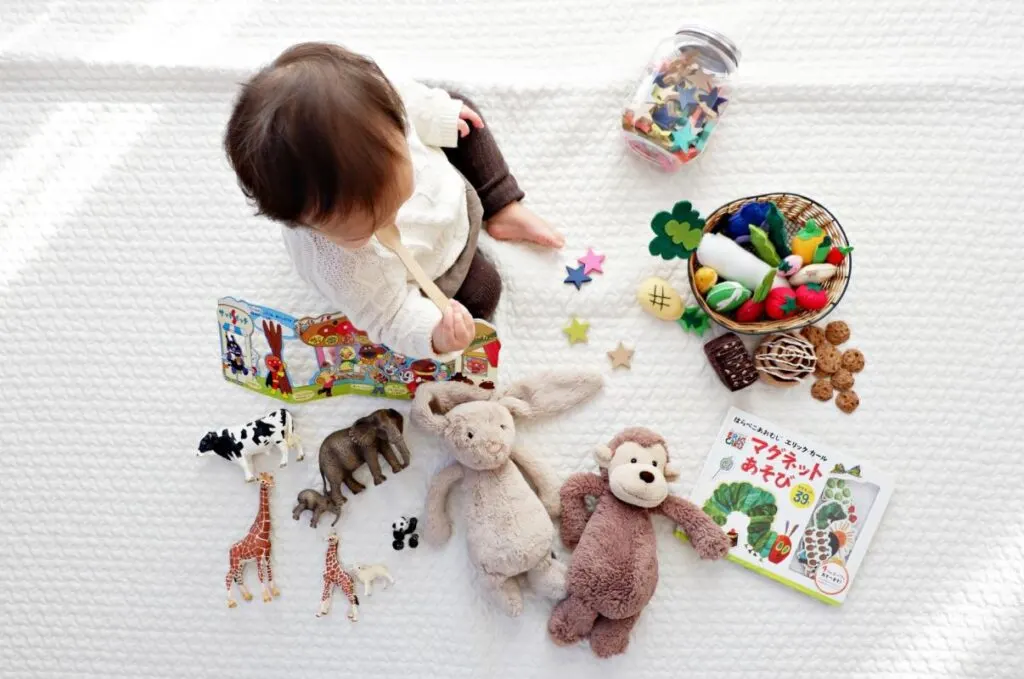Did you know that your child’s growing brain continues to develop and create most connections up to age 10?
Don’t worry though— development doesn’t stop there. It continues forever, but ages 1-10 are the most crucial for brain development.
If you have a child, are expecting, or work with kids, you will want to know about these important toys that encourage development.

Continue reading to discover some of the most important things that toys do to enhance brain development in children!
1. Learn Shapes & Colors
There are many different ways to increase brain development in children, especially with toys.
Toys, such as colored blocks, Legos, and sorting shapes, play a major role in child development. By physically holding these toys and looking at them, your child can start to tell shapes apart and identify colors.
By purchasing toys with contrasting colors, such as a ball that is half blue and half yellow, your child’s vision can further develop.
Contrasting colors won’t be as tricky in your child’s eyes. Even with a basic understanding, they will be able to realize that the colors are completely different.
To help your child learn shapes, you can buy toys that have a box, where you insert the specific shapes into. Your child will quickly learn that a square won’t fit into a circle.
It may take time for them to understand these shapes, but by looking at and touching each shape, they can make connections.
Many people recommend saying the colors and shapes out loud to help your child learn each one apart. As they begin to pick up on the answers, you can let them take over and guess.
2. Problem Solving Opportunities
Problem-solving needs to be addressed at all ages and toys definitely help with the task.
Children learn at a young age to problem solve and think outside of the box.
If a toy breaks or something falls, such a building blocks and legos, they then have to pick them back up and re-do their work or try something else.
If the building structure was weak on the bottom and kept falling over, your child will be able to identify the problem and address it.
Problem-solving is one of the most difficult stages of development, so you must be patient and help them learn.
Cause and effect toys are perfect for problem-solving skills. Video games can help older children develop these skills.
Another way that you can increase these learning opportunities is by taking a piece of their toy away and letting them figure out how to proceed.
Some children may look for an alternative toy to use in that place or they may go about searching for the item. Either way, they are using their brain to help resolve a problem!
Puzzles might seem like a boring toy, but they are perfect for problem-solving and come in so many varieties.
The next time you go to pick out a toy for your child, let them look over the puzzles and see if one jumps out. If you have an older child, consider getting a 3D puzzle for more interest and interaction.
3. Hear Different Sounds
The brain develops on many levels and auditory skills are one of the most important.
If you have a baby or infant, rattles are a good way to get their auditory skills developing. If they aren’t able to hold a rattle yet, you can get little shoes or toys with rattles included.
Your child will learn that each of their movements will create a beautiful noise.
Older children can play with musical instruments or singing toys to hear something new. The best part about this stage is that they may develop a lifelong love for music.
Instruments are a fun way to play with your child and they help play a role in developing auditory skills.
It is important that your child can identify different sounds and know where they are coming from.
Although there may be some loud and musical days, it will result in a strong understanding for your child. Many toys have built-in songs and encourage kids to sing along, try looking for these at the toy store!
If you don’t want to spend the money, you can even create musical instruments with items from around the house!

4. Language Acquisition
Listening to audiobooks and toys that respond to your child can help them learn a language and start on a path to speaking.
Language acquisition is crucial at all ages, and children tend to absorb the most words around ages 2 to 3 and can begin forming sentences.
Beyond age 3, children will still develop vocabulary and language acquisition, but they will understand most of the basics.
By getting toys that speak to your child by pressing a button, they can hear words and repeat them. They can also make connections.
Many people recommend getting animal wheels. You push the button to an animal’s picture and it says out loud the name of the animal and the sounds they make.
Dolls that speak when you press a button can improve language as well. Simply hearing the words said aloud will get your child further along in development.
Repetition is important at the early stages of language development. Although a toy might repeat itself and get annoying, it is greatly helping your child’s development.
5. Develop Fine Motor Skills
Many child development services include fine motor skills in their lesson plans.
Fine motor skills are necessary and are developed at 1-2 months old. These skills continue to grow through early elementary.
Younger infants can learn fine motor skills by sorting beads, sensory boards, and buckle toys. Fine motor skills are similar to hand and eye coordination except they often involve small pieces.
Buckles, zippers, and buttons can help develop fine motor skills and prepare your child for dressing themselves.
Always be cautious of what you give your children, though. Their little hands and fingers can easily get caught in a zipper if it is not suitable for their age.
Toddlers and older children can improve fine motor skills with jewelry making. Putting beads or macaroni on a necklace string takes a lot of practice.
Be sure that you encourage your child, even if they drop their string and need to start over.
6. Build the Imagination
If you want to help your child increase brain development, you should let them use their imagination!
Playing with barbies and dolls sparks the imagination for kids and gets them to form sentences and completing thoughts. They can create their own scenarios and play them out to prepare for the real world.
Besides dolls, your child can develop their imagination by using dress-up clothing and playing with house sets.
Often, your child may recreate scenes that they see in the home or on TV, but as their brain develops they can think of their own stories.
Grocery store, house, and kitchen playsets are ideal places for your child’s imagination to soar.
They can transport themselves to a different world and you can learn a lot about them while they learn how to play independently and creatively.
7. Prepare for Modern Learning
Many schools and jobs offer remote opportunities, where all of the work is done through the computer.
By getting your child electronic toys, they can develop an understanding of how to use them and prepare for the future.
Many games can be found on electronic devices, such as phones and tablets. Always be sure to monitor what your child is doing if there aren’t any parental controls up and they have access to the internet.
“Play” computers that have limited abilities are great starters for your children. You can let them play games on these devices without a worry and their brains can continue to develop.
Most people recommend limiting electronic toy time to kids under age 2 and as they age, they can spend more time utilizing them.
Blue light glasses for your little one might be a good thing to consider to help protect their eyes while their brain grows!
8. Enhance Hand & Eye Coordination
If you want to enhance your child’s hand and eye coordination, remote control toys are an excellent way to do so!
Hand and eye coordination are crucial for each of the child’s development stages. Remote control cars can help children with coordination.
They will learn that the movements they make with their hands directly impact what they are looking at. Video games are another way to improve coordination for those older kids.
If you have a baby or infant, they can learn hand and eye coordination with toys such as blocks and color ring sorting kits. Sorting colors and shapes is an easy go-to because most toys come in various colors.
Many people recommend using subtle physical cues to help your child if they are struggling with hand and eye coordination.
As they are looking at something, you can help direct their hands to the spots they need to go.

9. Improve Mobility
Brain development encompasses many things, including coordination and mobility skills.
Around age 1, your child will go through a significant change and become more mobile as they learn to crawl, walk, and run. Although muscles are needed to do these tasks, it also takes skill from the brain.
Placing your child in a stand-up bouncer and putting a water mat underneath, they can sense what is under their toes.
This will result in them working on walking and finding balance. Push cars and walkers can also improve mobility as your child develops coordination.
Do your best to babyproof the house while your child is in this stage, they may bump into a couple of things on their adventures.
Soon your crawling baby will be running around the house with you chasing after, especially if they play with the right toys!
10. Encourage Self-Soothing
Children learn how to self-soothe at a young age and this is a part of their development.
One of the best toys for building these skills is to introduce stuffed animals to your infant. The soft textures, clean scent, and adorable faces will keep your child curious and calm.
Spinning mobiles are another interactive toy that will keep your little one relaxed.
To encourage self-soothing and relaxation for your older children and toddlers, kinetic sand and sensory toys can get the job done. Kinetic sand is a fun toy and isn’t as messy as traditional sand.
There are magnetic pieces within the sand that help keep it together to avoid a messy play area.
Sensory toys, like water mats and creating slime can also be fun activities. Let your child use their imagination and calmly play with these toys, don’t get discouraged by the possibility of a mess!
Increase Brain Development in Children With These Toys
There are many ways to build brain development in children, especially with the help of toys.
Depending on where your child falls on a child development stages chart, some toys will help them.
Many skills begin developing at just a few months old, but they continue to develop much further beyond that.
If you want to teach your child hand and eye coordination or fine motor skills, blocks are most suitable for infants and toddlers.
Video games and remote control toys, however, would be beneficial for older children to play with.
Don’t be afraid to look down the toy aisle with your child and try to identify all of the benefits of each item they want.
Be sure to check out our blog for more articles about child development stages and learning with toys!